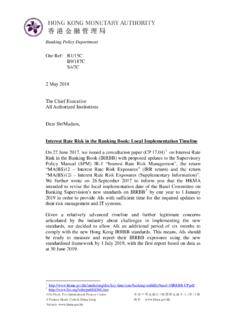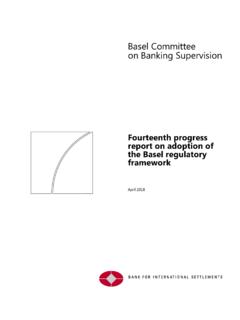Transcription of Basel Committee on Banking Supervision Standards
1 Basel Committee on Banking Supervision Standards Interest rate risk in the Banking book April 2016 This publication is available on the BIS website ( ). Bank for International Settlements 2016. All rights reserved. Brief excerpts may be reproduced or translated provided the source is stated. ISBN 978-92-9197-497-9 (print) ISBN 978-92-9197-498-6 (online) Interest rate risk in the Banking book iii Contents Executive summary .. 1 I. Introduction on irrbb .. 3 1. Definition of irrbb .. 3 2. Credit spread risk in the Banking book (CSRBB) .. 3 3. Economic value and earnings-based measures .. 3 II. The revised IRR Principles .. 4 1. Principles for banks .. 4 2. Principles for supervisors .. 18 III. Scope of application and implementation timeline .. 22 IV. The standardised framework .. 22 1. Overall structure of the standardised framework .. 22 2. Components of the standardised framework.
2 23 3. Treatment of NMDs .. 25 4. Treatment of positions with behavioural options other than NMDs .. 26 5. Automatic interest rate options .. 29 6. Calculation of the standardised EVE risk measure .. 30 Annex 1 .. 32 Annex 2 .. 44 Interest rate risk in the Banking book 1 Executive summary 1. Interest rate risk in the Banking book ( irrbb ) is part of the Basel capital framework s Pillar 2 (Supervisory Review Process) and subject to the Committee s guidance set out in the 2004 Principles for the management and Supervision of interest rate risk (henceforth, the IRR Principles).1 The IRR Principles lay out the Committee s expectations for banks identification, measurement, monitoring and control of irrbb as well as its Supervision . 2. The Committee has decided that the IRR Principles need to be updated to reflect changes in market and supervisory practices since they were first published, and this document contains an updated version that revises both the Principles and the methods expected to be used by banks for measuring, managing, monitoring and controlling such risks.
3 3. These updated Principles were the subject of consultation in 2015, when the Committee presented two options for the regulatory treatments of irrbb : a standardised Pillar 1 (Minimum Capital Requirements) approach and an enhanced Pillar 2 approach (which also included elements of Pillar 3 Market Discipline).2 The Committee noted the industry s feedback on the feasibility of a Pillar 1 approach to irrbb , in particular the complexities involved in formulating a standardised measure of irrbb which would be both sufficiently accurate and risk-sensitive to allow it to act as a means of setting regulatory capital requirements. The Committee concludes that the heterogeneous nature of irrbb would be more appropriately captured in Pillar 2. 4. Nonetheless, the Committee considers irrbb to be material, particularly at a time when interest rates may normalise from historically low levels. The key updates to the Principles under an enhanced Pillar 2 approach are as follows: Greater guidance has been provided on the expectations for a bank s irrbb management process, in particular the development of shock and stress scenarios (Principle 4) to be applied to the measurement of irrbb , the key behavioural and modelling assumptions which banks should consider in their measurement of irrbb (Principle 5) and the internal validation process which banks should apply for their internal measurement systems (IMS) and models used for irrbb (Principle 6).
4 The disclosure requirements under Principle 8 have been updated to promote greater consistency, transparency and comparability in the measurement and management of irrbb . Banks must disclose, among other requirements, the impact of interest rate shocks on their change in economic value of equity ( EVE) and net interest income ( NII), computed based on a set of prescribed interest rate shock scenarios. The supervisory review process under Principle 11 has been updated to elaborate on the factors which supervisors should consider when assessing the banks level and management of irrbb exposures. Supervisors could also mandate the banks under their respective jurisdictions to follow the standardised framework for irrbb (eg if they find that the bank s IMS does not adequately capture irrbb ). The standardised framework has been updated to enhance risk capture. 1 2 2 Interest rate risk in the Banking book Supervisors must publish their criteria for identifying outlier banks under Principle 12.
5 The threshold for the identification of an outlier bank has also been tightened, where the outlier/materiality test(s) applied by supervisors should at least include one which compares the bank s EVE with 15% of its Tier 1 capital, under a set of prescribed interest rate shock scenarios. Supervisors may implement additional outlier/materiality tests with their own specific measures. There is a strong presumption for supervisory and/or regulatory capital consequences, when a review of a bank s irrbb exposure reveals inadequate management or excessive risk relative to a bank s capital, earnings or general risk profile. 5. Consistent with the scope of application of the Basel II framework, the proposed framework would be applied to large internationally active banks on a consolidated basis. Supervisors have national discretion to apply the irrbb framework to other non-internationally active 6. The document is structured as follows.
6 Section I provides an introduction to irrbb . Section II presents the revised Principles, which replace the 2004 IRR Principles for defining supervisory expectations on the management of irrbb . Principles 1 to 7 are of general application for the management of irrbb , covering expectations for a bank s irrbb management process, in particular the need for effective irrbb identification, measurement, monitoring and control activities. Principles 8 and 9 set out the expectations for market disclosures and banks internal assessment of capital adequacy for irrbb respectively. Principles 10 to 12 address the supervisory approach to banks irrbb management framework and capital adequacy. Section III states the scope of application and Section IV sets out the standardised framework which supervisors could mandate their banks to follow, or a bank could choose to adopt. The Annexes provide a set of terminology and definitions that will provide a better understanding of irrbb to both banks and supervisors (Annex 1) and further details on the standardised interest rate shocks (Annex 2).
7 7. The banks are expected to implement the Standards by 3 See BCBS, International Convergence of Capital Measurement and Capital Standards : A Revised Framework Comprehensive Version, June 2006. 4 For avoidance of doubt, this means that, for banks whose financial year ends on 31 December, the relevant disclosures would have to be made in 2018, based on the information as at 31 December 2017. Interest rate risk in the Banking book 3 I. Introduction on irrbb 8. irrbb refers to the current or prospective risk to the bank s capital and earnings arising from adverse movements in interest rates that affect the bank s Banking book positions. When interest rates change, the present value and timing of future cash flows change. This in turn changes the underlying value of a bank s assets, liabilities and off-ba lance sheet items and hence its economic value. Changes in interest rates also affect a bank s earnings by altering interest rate-sensitive income and expenses, affecting its net interest income (NII).
8 Excessive irrbb can pose a significant threat to a bank s current capital base and/or future earnings if not managed appropriately. 1. Definition of irrbb 9. Three main sub-types of irrbb are defined for the purposes of these Principles: (a) Gap risk arises from the term structure of Banking book instruments, and describes the risk arising from the timing of instruments rate changes. The extent of gap risk depends on whether changes to the term structure of interest rates occur consistently across the yield curve (parallel risk) or differentially by period (non-parallel risk). (b) Basis risk describes the impact of relative changes in interest rates for financial instruments that have similar tenors but are priced using different interest rate indices. (c) Option risk arises from option derivative positions or from optional elements embedded in a bank s assets, liabilities and/or off-balance sheet items, where the bank or its customer can alter the level and timing of their cash flows.
9 Option risk can be further characterised into automatic option risk and behavioural option risk. All three sub-types of irrbb potentially change the price/value or earnings/costs of interest rate-sensitive assets, liabilities and/or off-balance sheet items in a way, or at a time, that can adversely affect a bank s financial condition. Annex 1 provides a more detailed description of irrbb and its management techniques. 2. Credit spread risk in the Banking book (CSRBB) 10. While the three sub-types listed above are directly linked to irrbb , CSRBB is a related risk that banks need to monitor and assess in their interest rate risk management framework. CSRBB refers to any kind of asset/liability spread risk of credit-risky instruments that is not explained by irrbb and by the expected credit/jump to default risk. 3. Economic value and earnings-based measures 11. While the economic value and earnings-based measures share certain commonalities, the Committee observes that most commercial banks primarily utilise the latter for irrbb management, whereas regulators tend to endorse the former as a benchmark for comparability and capital adequacy.
10 The Committee acknowledges the importance of managing irrbb through both economic value and earnings-based measures. If a bank solely minimises its economic value risk by matching the repricing of its assets with liabilities beyond the short term, it could run the risk of earnings volatility. 4 Interest rate risk in the Banking book II. The revised IRR Principles 1. Principles for banks Principle 1: irrbb is an important risk for all banks that must be specifically identified, measured, monitored and controlled. In addition, banks should monitor and assess CSRBB. Background 12. irrbb is an important risk that arises from Banking activities, and is encountered by all banks. It arises because interest rates can vary significantly over time, while the business of Banking typically involves intermediation activity that produces exposures to both maturity mismatch (eg long-maturity assets funded by short-maturity liabilities) and rate mismatch (eg fixed rate loans funded by variable rate deposits).













